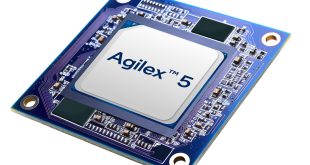The new, highly scalable AMD “Zen” microarchitecture is the latest x86 benchmark. It offers drastically increased computing speed, energy efficiency and performance-per-watt to the consumer, workstation and server markets. These outstanding value propositions could be of great use for embedded applications as well.
In March 2017, AMD shipped the first new “Zen” microarchitecture processors acclaimed to deliver extraordinary efficiency gains. In detail, the single-thread performance offers 52 per cent more instructions per clock cycle (IPC) compared to the previous Excavator architecture, while the performance-per-watt was improved by 270 per cent. As is common in the consumer segment, technology experts verified these officially announced improvements – and the new processors delivered!
Great value for office and gaming
The new AMD Ryzen 5 1600X processor, for example, provides up to 87 per cent more generic processing performance compared to the current Intel Core i5-7600K processor. Performance hungry image rendering and video transcoding demos based on Blender and Handbrake showed that an AMD 8-core Ryzen CPU can match or even outperform the Intel Core i7-6900K processor – also an 8-core, 16-thread processor – in many complex creative tasks. The 140W TDP Core i7-6900K ran at stock processor speed and boost against the far less power hungry 95W TDP Ryzen processor at 3.4 GHz without boost. In Cinebench R15, the AMD Ryzen 7 1800X excelled with 1601.43 over the Intel Core i7-6900K Extreme by nice per cent, which only scored 1473.79. But performance is only one side of the medal, efficiency the other. Here too the AMD Ryzen processors delivered exceptional value. For example, the AMD Ryzen 7 1700 processor offered 18.22 per cent more performance per watt than the Intel Core i7-6900K. Both systems ran a Cinebench R15 benchmark. The AMD processor consumed 115W to reach a score of 1410, whereas the Intel system needed 142W for a score of 1473 (power efficiency: 1410/115W=12.26 points per watt (1700) vs. 1473/142W=10.37 points per watt (6900K)). These benchmarks are important for the desktop, workstation and PC gaming markets. Moreover the Zen microarchitecture scales easily up to enthusiast level applications demanding 16 cores and more. This is demonstrated by the new AMD Threadripper processors. According to third party tests with benchmarks such as Cinebench R15, the AMD Ryzen Threadripper 1950X offers 34 per cent more performance than the comparable Intel Core i9-7900X processor.
Superior server efficiency
Moving on to true data center workloads including high-performance computing, virtualised cloud computing, machine learning, Big Data, and other analytics tasks where coding is required, here too Zen scores extraordinary results: The new AMD EPYC 7601 system on chip sets a total of four new world records for standalone CPUs on the SPEC CPU 2006 benchmarks for dual-socket and single-socket servers. On dual-socket servers it offers up to 25 per cent better integer performance and up to 59 per cent better floating point performance compared to the Intel Xeon processor E5-2699A V4. For single-socket servers, it even features 32 per cent better integer performance and up to 66 per cent better floating point performance.
The new Zen microarchitecture
Responsible for all these superior performance results are several improvements implemented into the Zen microarchitecture. In order to efficiently build a single platform for various x86 use cases, AMD combined 4 Zen cores in a CPU Complex (CCX) with up to 16 MB L3 Cache, where every core can access the entire cache with the same latency.
The Zen cores are based on energy-efficient FinFET transistors with 14nm technology, which packs more transistors on a smaller die size, making the chip denser and more power-efficient. In addition, they offer a groundbreaking design that is optimised to provide high single-thread performance; and for better multitasking capabilities, they are the first AMD processors featuring full simultaneous multithreading for high throughput, which means that for the first time two threads can be processed in parallel.

Innovative technologies also help to optimise performance, power consumption and heat dissipation in real life applications: The new Pure Power technology further optimises voltage, clock frequency and operation modes to achieve minimal energy consumption. It is accompanied by Precision Boost to optimise the clock speed for each core individually, and Extended Frequency Range to extend the core frequency when additional thermal headroom is sensed. In addition, the Zen cores integrate an artificial intelligence neural network called Neural Net Prediction that learns to predict what future pathway an application will take based on past runs. Finally, Smart Prefetch, which is based on sophisticated learning algorithms, tracks software behavior to anticipate the needs of an application and prepare the data in advance.
A perfect fit for embedded
With these brand new features and superior performance per watt capabilities, the Zen architecture would also be a perfect fit for the embedded segments. For example, AMD recently announced that mobile APUs will also become available on the basis of the new architecture, featuring integrated “Vega” graphics, “Raven Ridge” for premium 2-in-1s, ultra portables, and gaming form factors. These upcoming processors would be a perfect fit for all typical high-performance embedded applications, such as casino gaming, panel PCs and industrial box PCs for automation as well as medical systems.
Upcoming headless processors with the new Zen processing cores could make a great computing engine for all the various edge and fog servers which reside at the edge of the IoT and not in air-conditioned server rooms. Here, they can host all the new telecommunications, industrial automation, Industry 4.0 and medical applications that require data center performance in close proximity to the applications. And if these processors are accompanied by a high-performance embedded graphics card, they could also be a perfect platform for medical workstations with high-quality visuals offering resolutions beyond 4k and HDR capabilities, as well as high-end digital signage applications with twelve or even more independent displays for a superior customer experience. With their scalable PCIe connectivity, new AMD processors with Zen microarchitecture would also be a most powerful basis for high-end medical imaging like back-end systems in MRIs that rely on multiple GPGPU cards to process images and/or video streams in shortest times. Also, all embedded machine learning applications for collaborative robotics and autonomous intra-logistic vehicles could greatly benefit from the increased computing capabilities, simplified single-socket server design and improved connectivity that the new AMD server processors with GPGPUs offer. Additionally the Zen microarchitecture can also be scaled to even satisfy the high demands of autonomous vehicles, where even more cores and parallel processing engines are required.
Conclusion
With the new Zen architecture, AMD has built the foundation for a shift in x86 power relations. As the technology industry is transitioning to immersive and instinctive computing that requires the high-performance computing capabilities and increased graphics performance offered by the AMD Ryzen and EPYC processors, the new Zen technology presents great value. And since AMD is the only company that offers both CPUs and GPUs it is in a perfect position to fulfill these market demands. As the engagement from AMD in the embedded segment has been very strong over the last few decade, it is reasonable to expect that variants of this new benchmark microarchitecture will also become available to the embedded market. Many embedded engineers might think: The sooner the better. Rumors name Embedded World 2018 as launch date. So now is a good time to talk to AMD to get the boards ready for the most perfect launch wave.
 CIE Components in Electronics
CIE Components in Electronics



